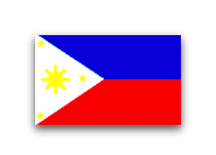



|
|
|
|
|
|
|
|
|
|
|
|

| 1521: Magellan discovered the Philippine Islands. While trying
to subdue the native chief, Lapulapu, on Mactan he was killed in a
skirmish by the Mactan warriors.
The Philippines was named after the Crown Prince Philip II of Spain. He reigned over the vast Spanish empire handed down by his father, Charles V, and was a leading patron of Catholicism. 1941: Japanese forces landed on Luzon and by 1942 they took over Manila. U.S. troops on the Bataan peninsula surrendered to General Yamashita. Three years later U.S. forces invaded the Philippines under the command of General Douglas MacArthur and recovered Manila within three weeks. 1972: Philippine President Ferdinand Marcos declared martial law in response to an alleged "Communist rebellion" and assumed near- dictatorial powers. Eight years later he ended martial law and won an election to a second six year term and continued his reign of communism over a suppressed society. 1983: Former Philippine Senator Benigno Aquino returned from exile to Manila and was assassinated upon arrival to the Manila Airport. Later his wife, Corazon Aquino, ran and won the election for presidency amidst ballot tampering by Marcos' supporters. Under U.S. pressure Marcos was forced to leave Manila and was flown to Guam. He was given sanctuary in Hawaii where he died in 1989 after 20 years of embezzling the country of $5 billion. 1991: Mount Pinatubo on Luzon erupted destroying everything in its path, caking fields, roads and vehicles with gray ash, closing airports and forcing the evacuation of 20,000 Americans from Clark Air Base and Subic Bay Naval Station. |


